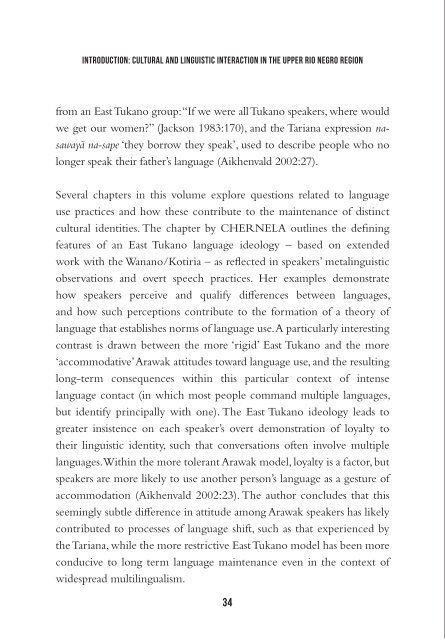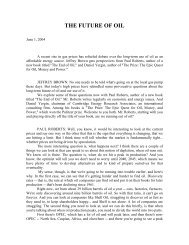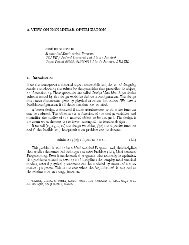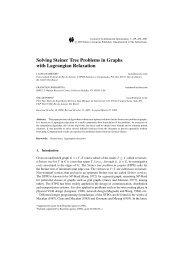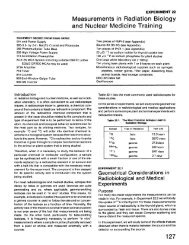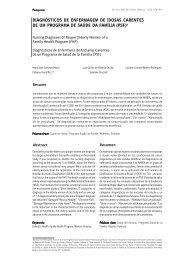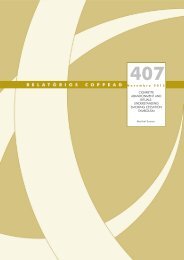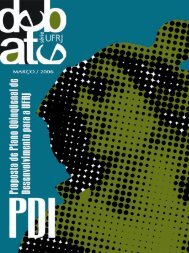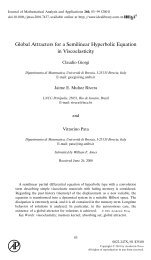Upper Rio Negro - Museu Nacional - UFRJ
Upper Rio Negro - Museu Nacional - UFRJ
Upper Rio Negro - Museu Nacional - UFRJ
Create successful ePaper yourself
Turn your PDF publications into a flip-book with our unique Google optimized e-Paper software.
introduction: cultural and linguistic interaction in the upper rio negro region<br />
Patience Epps and kristine stenzel<br />
from an East Tukano group: “If we were all Tukano speakers, where would<br />
we get our women” (Jackson 1983:170), and the Tariana expression nasawayã<br />
na-sape ‘they borrow they speak’, used to describe people who no<br />
longer speak their father’s language (Aikhenvald 2002:27).<br />
Several chapters in this volume explore questions related to language<br />
use practices and how these contribute to the maintenance of distinct<br />
cultural identities. The chapter by CHERNELA outlines the defining<br />
features of an East Tukano language ideology – based on extended<br />
work with the Wanano/Kotiria – as reflected in speakers’ metalinguistic<br />
observations and overt speech practices. Her examples demonstrate<br />
how speakers perceive and qualify differences between languages,<br />
and how such perceptions contribute to the formation of a theory of<br />
language that establishes norms of language use. A particularly interesting<br />
contrast is drawn between the more ‘rigid’ East Tukano and the more<br />
‘accommodative’ Arawak attitudes toward language use, and the resulting<br />
long-term consequences within this particular context of intense<br />
language contact (in which most people command multiple languages,<br />
but identify principally with one). The East Tukano ideology leads to<br />
greater insistence on each speaker’s overt demonstration of loyalty to<br />
their linguistic identity, such that conversations often involve multiple<br />
languages. Within the more tolerant Arawak model, loyalty is a factor, but<br />
speakers are more likely to use another person’s language as a gesture of<br />
accommodation (Aikhenvald 2002:23). The author concludes that this<br />
seemingly subtle difference in attitude among Arawak speakers has likely<br />
contributed to processes of language shift, such as that experienced by<br />
the Tariana, while the more restrictive East Tukano model has been more<br />
conducive to long term language maintenance even in the context of<br />
widespread multilingualism.<br />
While linguistic codes may differ, the linguistically mediated interaction<br />
among many of the <strong>Rio</strong> <strong>Negro</strong> groups is profound. Frequent interaction<br />
shapes discourse in the region (cf. Beier et al. 2002): we find widely<br />
shared themes and discursive strategies in narrative, especially within the<br />
Vaupés, but also among the Baniwa and other Arawak groups in the<br />
broader region. For example, stories with similar themes and protagonists<br />
turn up across language groups (such as the tale of the tortoise who<br />
pursued the tapir and killed him by biting him in a very sensitive spot,<br />
told by speakers of Hup, Tariana, and various East Tukano languages).<br />
Similarly, shamanic incantations in different language groups reveal<br />
closely comparable structure and content; compare Buchillet (1992) on<br />
Desana to the Hup incantations recorded by Epps and by Danilo Paiva<br />
Ramos (e.g. Epps 2008a:916; Ramos p.c. to Epps).<br />
Similarities in discourse also include close resemblances in music and song,<br />
as can be seen in Piedade’s (1997) comparison of the Wakuénai/Kurripako<br />
Arawak and Tukano musical traditions. HOSEMANN focuses on this<br />
topic in her discussion of <strong>Upper</strong> <strong>Rio</strong> <strong>Negro</strong> women’s song exchanges, as<br />
observed among Kotiria/Wanano, Wakuénai, and Hup women. In these<br />
exchanges, the theme of ‘women as outsiders’ is pervasive, regardless of<br />
the extent to which the performing woman is in fact an outsider in her<br />
particular living situation. Thus, the genre on the one hand reflects a<br />
collective recognition of women’s placement in exogamous, patrilocal<br />
societies, and an acknowledgement that experiences of solitude, isolation,<br />
and even poverty are commonly shared. On the other hand, the author<br />
points out the flexibility inherent to the genre, which allows singers the<br />
freedom to improvise and create dialogue about particular circumstances<br />
involving themselves or their listeners.<br />
34 35


